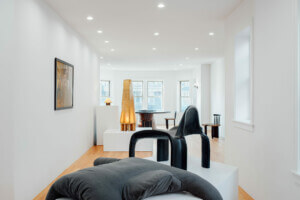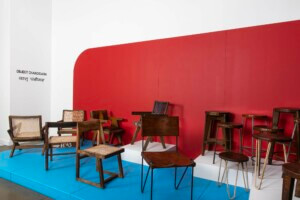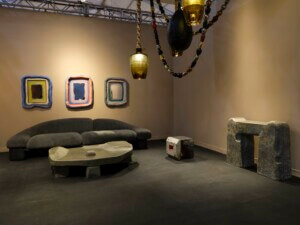Goetz Composites fabricated the Granoff Collection of modular furniture for a new Diller, Scofidio + Renfro-designed building at Brown University.
Brown University’s Granoff Center for the Creative Arts, completed by Diller, Scofidio + Renfro in 2010, was a direct result of the institution’s studies on how students and faculty interact today. Since most interdisciplinary exchanges were taking place in stairwells over classrooms, the architects designed a central escalier with five landings where the school’s population could meet among rotating student installations. One year after the building opened, the users realized that something was missing on the escalier: a place to sit. To rectify the situation, graduate students from the Rhode Island School of Design (RISD) collaborated with Brown alumni to design a unique collection of furniture named for the building’s patrons, Perry and Marty Granoff.
The alumni designers—Taylor McKenzie-Veal, Scot Bailey, Ian Stell, and Yumi Yoshida—crafted a line of modular furniture that includes a sofa, a chair, and a table that doubles as a stool. The line caters to local industry in materiality; namely the state’s maritime history. “The boating and composite expertise in Rhode Island has a long-standing history of excellence and [we] consulted and collaborated with a local composites and engineering firm while developing and prototyping the design,” said McKenzie-Veal.
- Fabricators Goetz Composites
- Designers Taylor McKenzie-Veal, Scot Bailey, Ian Stell, and Yumi Yoshida
- Location Providence, Rhode Island
- Date of Completion February 2013
- Material MDF, fiber reinforced plastic, linear polyurethane
- Process Rhino, CNC mill
Bristol, Rhode Island-based Goetz Composites worked to realize the designers’ vision for a flexible line of furniture that could be used in various configurations. The sofa, for example, is constructed from a large corner section, a small corner section, and a small center section that can be pulled apart and put together in whatever way the user wishes. “The designers had a very specific look in mind, both in texture and color,” said Chase Hogoboom, president of Goetz Composites. “A lot of time and effort was spent working with the designers to develop the [fabrication] process and achieve the results they were looking for.”
To develop a prototype, the design team gave Hogoboom three-dimensional Rhino files outlining each section’s shape and dimensions. The fabricator used RhinoCAM to program the form and a CNC mill to cut medium density fiberboard to the exact shape specified by the designers’ files. “There were very strict requirements for the radius of the edges,” said Hogoboom. Additionally, the design schematic called for two A surfaces, so the front and back of the sofa had to be identical.
Once the designers approved the prototype, the fabricators used a custom CNC-cut tool to make the shells of the furniture sections from fiber reinforced plastic (FRP). “The furniture was built for an institutional environment, so it needs to withstand heavy use from students, staff, and visitors,” explained Hogoboom. “Based on the profile of the pieces, it had to be low and streamlined, and we were able to achieve that through the materials we used.” Once the FRP was cut, the fabricator wet sanded—with 1,200 grit—and buffed the sections. Linear polyurethane—air craft-quality paint—was applied in crayon-inspired hues and the sections were bolted into metal frames with integrated cleats. The series is finished off with bright cushions from local upholsterer AJ Read.
The sofa is currently on display in Milan as part of the exhibition, Risk and Certainty in Uncertain Times, curated by RISD president John Maeda, and will travel to the States for New York’s Design Week in May.










